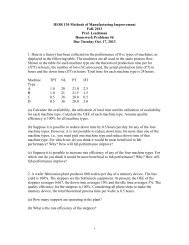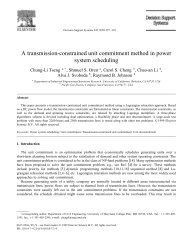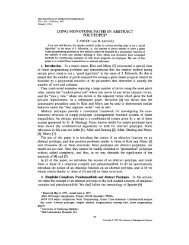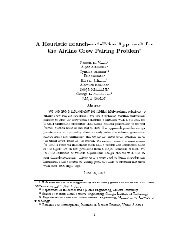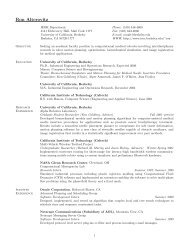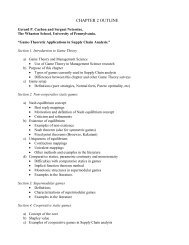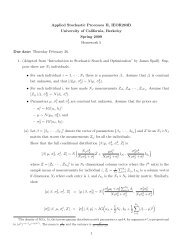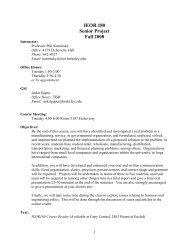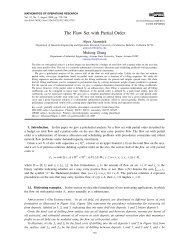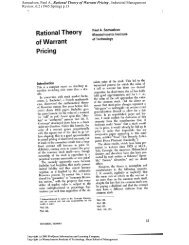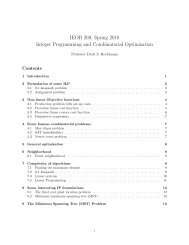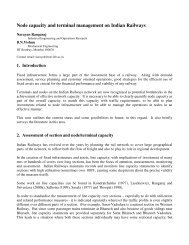The Link between Default and Recovery Rates: Theory, Empirical ...
The Link between Default and Recovery Rates: Theory, Empirical ...
The Link between Default and Recovery Rates: Theory, Empirical ...
You also want an ePaper? Increase the reach of your titles
YUMPU automatically turns print PDFs into web optimized ePapers that Google loves.
Edward I. Altman<br />
Stern School of Business, New York University<br />
Brooks Brady<br />
St<strong>and</strong>ard <strong>and</strong> Poor’s<br />
Andrea Resti<br />
Bocconi University, Italy<br />
Andrea Sironi<br />
Bocconi University, Milan<br />
<strong>The</strong> <strong>Link</strong> <strong>between</strong> <strong>Default</strong><br />
<strong>and</strong> <strong>Recovery</strong> <strong>Rates</strong>: <strong>The</strong>ory,<br />
<strong>Empirical</strong> Evidence,<br />
<strong>and</strong> Implications*<br />
I. Introduction<br />
Credit risk affects virtually every financial contract.<br />
<strong>The</strong>refore the measurement, pricing, <strong>and</strong> management<br />
of credit risk have received much attention<br />
from financial economists, bank supervisors <strong>and</strong><br />
regulators, <strong>and</strong> financial market practitioners. Following<br />
the recent attempts of the Basel Committee<br />
on Banking Supervision (1999, 2001) to reform<br />
the capital adequacy framework by introducing<br />
risk-sensitive capital requirements, significant<br />
* This paper is a significant extension of a report prepared for<br />
the International Swaps <strong>and</strong> Dealers Association (ISDA; 2000).<br />
We thank ISDA for its financial <strong>and</strong> intellectual support. We<br />
thank Richard Herring, Hiroshi Nakaso, <strong>and</strong> the other participants<br />
at the BIS conference (March 6, 2002) on ‘‘Changes in Risk<br />
through Time: Measurement <strong>and</strong> Policy Options’’ (London) for<br />
their useful comments. <strong>The</strong> paper also profited by the comments<br />
from participants in the CEMFI (Madrid, Spain) Workshop<br />
on April 2, 2002, especially Rafael Repullo, Enrique Sentana,<br />
<strong>and</strong> Jose Campa; from workshops at the Stern School of Business<br />
(NYU), University of Antwerp, University of Verona, <strong>and</strong><br />
Bocconi University; <strong>and</strong> from an anonymous reviewer.<br />
(Journal of Business, 2005, vol. 78, no. 6)<br />
B 2005 by <strong>The</strong> University of Chicago. All rights reserved.<br />
0021-9398/2005/7806-0006$10.00<br />
This paper analyzes the<br />
association <strong>between</strong><br />
default <strong>and</strong> recovery<br />
rates on credit assets<br />
<strong>and</strong> seeks to empirically<br />
explain this critical<br />
relationship. We<br />
examine recovery rates<br />
on corporate bond<br />
defaults over the period<br />
1982–2002. Our<br />
econometric univariate<br />
<strong>and</strong> multivariate models<br />
explain a significant<br />
portion of the variance<br />
in bond recovery rates<br />
aggregated across<br />
seniority <strong>and</strong> collateral<br />
levels. We find that<br />
recovery rates are a<br />
function of supply<br />
<strong>and</strong> dem<strong>and</strong> for the<br />
securities, with default<br />
rates playing a pivotal<br />
role. Our results have<br />
important implications<br />
for credit risk models<br />
<strong>and</strong> for the procyclicality<br />
effects of the New Basel<br />
Capital Accord.<br />
2203
2204 Journal of Business<br />
additional attention has been devoted to the subject of credit risk measurement<br />
by the international regulatory, academic, <strong>and</strong> banking communities.<br />
This paper analyzes <strong>and</strong> measures the association <strong>between</strong> aggregate<br />
default <strong>and</strong> recovery rates on corporate bonds <strong>and</strong> seeks to empirically<br />
explain this critical relationship. After a brief review of the way credit<br />
risk models explicitly or implicitly treat the recovery rate variable,<br />
Section III examines the recovery rates on corporate bond defaults over<br />
the period 1982–2002. We attempt to explain recovery rates by specifying<br />
rather straightforward linear, logarithmic, <strong>and</strong> logistic regression<br />
models. <strong>The</strong> central thesis is that aggregate recovery rates are basically<br />
a function of supply <strong>and</strong> dem<strong>and</strong> for the securities. Our econometric<br />
univariate <strong>and</strong> multivariate time-series models explain a significant portion<br />
of the variance in bond recovery rates aggregated across all seniority<br />
<strong>and</strong> collateral levels. In Sections IV <strong>and</strong> V, we briefly examine<br />
the effects of the relationship <strong>between</strong> defaults <strong>and</strong> recoveries on credit<br />
VaR (value at risk) models <strong>and</strong> the procyclicality effects of the new<br />
capital requirements proposed by the Basel Committee, then conclude<br />
with some remarks on the general relevance of our results.<br />
II. <strong>The</strong> Relationship <strong>between</strong> <strong>Default</strong> <strong>Rates</strong> <strong>and</strong> <strong>Recovery</strong> <strong>Rates</strong> in Credit<br />
Risk Modeling: A Review of the Literature<br />
Credit risk models can be divided into three main categories: (1) ‘‘first<br />
generation’’ structural-form models, (2) ‘‘second generation’’ structuralform<br />
models, <strong>and</strong> (3) reduced-form models. Rather than go through a<br />
discussion of each of these well-known approaches <strong>and</strong> their advocates in<br />
the literature, we refer the reader to our earlier report for ISDA (Altman,<br />
Resti, <strong>and</strong> Sironi 2001), which carefully reviews the literature on the<br />
conceptual relationship <strong>between</strong> the firm’s probability of default (PD) <strong>and</strong><br />
the recovery rate (RR) after default to creditors. 1<br />
During the last few years, new approaches explicitly modeling <strong>and</strong><br />
empirically investigating the relationship <strong>between</strong> PD <strong>and</strong> RR have been<br />
developed. <strong>The</strong>se include Frye (2000a, 2000b), Jokivuolle <strong>and</strong> Peura<br />
(2003), <strong>and</strong> Jarrow (2001). <strong>The</strong> model proposed by Frye draws from the<br />
conditional approach suggested by Finger (1999) <strong>and</strong> Gordy (2000). In<br />
these models, defaults are driven by a single systematic factor–the state<br />
of the economy–rather than by a multitude of correlation parameters.<br />
<strong>The</strong> same economic conditions are assumed to cause defaults to rise, for<br />
example, <strong>and</strong> RRs to decline. <strong>The</strong> correlation <strong>between</strong> these two variables<br />
therefore derives from their common dependence on the systematic<br />
factor. <strong>The</strong> intuition behind Frye’s theoretical model is relatively simple:<br />
if a borrower defaults on a loan, a bank’s recovery may depend on the<br />
value of the loan collateral. <strong>The</strong> value of the collateral, like the value of<br />
1. See Altman, Resti <strong>and</strong> Sironi (2001) for a formal discussion of this relationship.
<strong>Default</strong> <strong>and</strong> <strong>Recovery</strong> <strong>Rates</strong><br />
2205<br />
other assets, depends on economic conditions. If the economy experiences<br />
a recession, RRs may decrease just as default rates tend to increase.<br />
This gives rise to a negative correlation <strong>between</strong> default rates <strong>and</strong> RRs.<br />
<strong>The</strong> model originally developed by Frye (2000a) implied recovery from<br />
an equation that determines collateral. His evidence is consistent with the<br />
most recent U.S. bond market data, indicating a simultaneous increase in<br />
default rates <strong>and</strong> losses given default (LGDs) 2 in 1999–2001. 3 Frye’s<br />
(2000b, 2000c) empirical analysis allows him to conclude that, in a<br />
severe economic downturn, bond recoveries might decline 20–25 percentage<br />
points from their normal-year average. Loan recoveries may<br />
decline by a similar amount but from a higher level.<br />
Jarrow (2001) presents a new methodology for estimating RRs <strong>and</strong><br />
PDs implicit in both debt <strong>and</strong> equity prices. As in Frye (2000a, 2000b),<br />
RRs <strong>and</strong> PDs are correlated <strong>and</strong> depend on the state of the economy. However,<br />
Jarrow’s methodology explicitly incorporates equity prices in the estimation<br />
procedure, allowing the separate identification of RRs <strong>and</strong> PDs<br />
<strong>and</strong> the use of an exp<strong>and</strong>ed <strong>and</strong> relevant data set. In addition, the methodology<br />
explicitly incorporates a liquidity premium in the estimation procedure,<br />
which is considered essential in the light of the high variability in<br />
the yield spreads <strong>between</strong> risky debt <strong>and</strong> U.S. Treasury securities.<br />
A rather different approach is proposed by Jokivuolle <strong>and</strong> Peura<br />
(2000). <strong>The</strong> authors present a model for bank loans in which collateral<br />
value is correlated with the PD. <strong>The</strong>y use the option pricing framework<br />
for modeling risky debt: the borrowing firm’s total asset value determines<br />
the event of default. However, the firm’s asset value does not<br />
determine the RR. Rather, the collateral value is in turn assumed to be<br />
the only stochastic element determining recovery. Because of this assumption,<br />
the model can be implemented using an exogenous PD, so that<br />
the firm’s asset value parameters need not be estimated. In this respect,<br />
the model combines features of both structural-form <strong>and</strong> reduced-form<br />
models. Assuming a positive correlation <strong>between</strong> a firm’s asset value <strong>and</strong><br />
collateral value, the authors obtain a result similar to Frye (2000a), that<br />
realized default rates <strong>and</strong> recovery rates have an inverse relationship.<br />
Using Moody’s historical bond market data, Hu <strong>and</strong> Perraudin (2002)<br />
examine the dependence <strong>between</strong> recovery rates <strong>and</strong> default rates. <strong>The</strong>y<br />
first st<strong>and</strong>ardize the quarterly recovery data to filter out the volatility of<br />
recovery rates given by the variation over time in the pool of borrowers<br />
rated by Moody’s. <strong>The</strong>y find that correlations <strong>between</strong> quarterly<br />
recovery rates <strong>and</strong> default rates for bonds issued by U.S.-domiciled<br />
2. LGD indicates the amount actually lost (by an investor or a bank) for each dollar lent<br />
to a defaulted borrower. Accordingly, LGD <strong>and</strong> RR always add to 1. One may also factor<br />
into the loss calculation the last coupon payment, which is usually not realized when a<br />
default occurs (see Altman 1989).<br />
3. Gupton, Hamilton, <strong>and</strong> Berthault (2001) provide clear empirical evidence of this<br />
phenomenon.
2206 Journal of Business<br />
obligors are 0.22 for post 1982 data (1983–2000) <strong>and</strong> 0.19 for the<br />
1971–2000 period. Using extreme value theory <strong>and</strong> other nonparametric<br />
techniques, they also examine the impact of this negative correlation<br />
on credit VaR measures <strong>and</strong> find that the increase is statistically<br />
significant when confidence levels exceed 99%.<br />
Bakshi, Madan, <strong>and</strong> Zhang (2001) enhance the reduced-form models<br />
presented earlier to allow for a flexible correlation <strong>between</strong> the riskfree<br />
rate, the default probability, <strong>and</strong> the recovery rate. Based on some<br />
preliminary evidence published by rating agencies, they force recovery<br />
rates to be negatively associated with default probability. <strong>The</strong>y find some<br />
strong support for this hypothesis through the analysis of a sample of<br />
BBB-rated corporate bonds: more precisely, their empirical results show<br />
that, on average, a 4% worsening in the (risk-neutral) hazard rate is associated<br />
with a 1% decline in (risk-neutral) recovery rates.<br />
Compared to the aforementioned contributions, our study extends<br />
the existing literature in three main directions. First, the determinants<br />
of defaulted bonds’ recovery rates are empirically investigated. While<br />
most of the aforementioned recent studies concluded in favor of an<br />
inverse relationship <strong>between</strong> these two variables, based on the common<br />
dependence on the state of the economy, none of them empirically<br />
analyzed the more specific determinants of recovery rates. While our<br />
analysis shows empirical results that appear consistent with the intuition<br />
of a negative correlation <strong>between</strong> default rates <strong>and</strong> RRs, we find that a<br />
single systematic risk factor (the performance of the economy) is less<br />
predictive than the aforementioned theoretical models would suggest.<br />
Second, our study is the first one to examine, both theoretically <strong>and</strong><br />
empirically, the role played by supply <strong>and</strong> dem<strong>and</strong> of defaulted bonds in<br />
determining aggregate recovery rates. Our econometric univariate <strong>and</strong><br />
multivariate models assign a key role to the supply of defaulted bonds <strong>and</strong><br />
show that these variables together with variables that proxy the size of the<br />
high-yield bond market explain a substantial proportion of the variance in<br />
bond recovery rates aggregated across all seniority <strong>and</strong> collateral levels.<br />
Third, our simulations show the consequences the negative correlation<br />
<strong>between</strong> default <strong>and</strong> recovery rates would have on VaR models <strong>and</strong><br />
the procyclicality effect of the capital requirements recently proposed<br />
by the Basel Committee. Indeed, while our results on the impact of this<br />
correlation on credit risk measures (such as unexpected loss <strong>and</strong> value at<br />
risk) are in line with the ones obtained by Hu <strong>and</strong> Perraudin (2002), they<br />
show that, if a positive correlation highlighted by bond data were to be<br />
confirmed by bank data, the procyclicality effects of ‘‘Basel II’’ might<br />
be even more severe than expected if banks use their own estimates of<br />
LGD. Indeed, the Basel Commission assigned a task force in 2004 to<br />
analyze ‘‘recoveries in downturns’’ in order to assess the significance of a<br />
decrease in activity on LGD. A report was issued in July 2005 with some<br />
guidelines for banks ({ 468 of the framework document).
<strong>Default</strong> <strong>and</strong> <strong>Recovery</strong> <strong>Rates</strong><br />
2207<br />
As concerns specifically the Hu <strong>and</strong> Perraudin paper, it should be<br />
pointed out that they correlate recovery rates (or percent of par, which is<br />
the same thing) with issuer-based default rates. Our models assess the<br />
relationship <strong>between</strong> dollar-denominated default <strong>and</strong> recovery rates <strong>and</strong>,<br />
as such, can assess directly the supply/dem<strong>and</strong> aspects of the defaulted<br />
debt market. Moreover, in addition to assessing the relationship <strong>between</strong><br />
default <strong>and</strong> recovery rates using ex post default rates, we explore the effect<br />
of using ex ante estimates of the future default rates (i.e., default probabilities)<br />
instead of actual, realized defaults. As will be shown, however,<br />
while the negative relationship <strong>between</strong> RR <strong>and</strong> both ex post <strong>and</strong> ex ante<br />
default rates is empirically confirmed, the probabilities of default show a<br />
considerably lower explanatory power. Finally, it should be emphasized<br />
that, while our paper <strong>and</strong> the one by Hu <strong>and</strong> Perraudin reach similar<br />
conclusions, albeit from very different approaches <strong>and</strong> tests, it is important<br />
that these results become accepted <strong>and</strong> are subsequently reflected<br />
in future credit risk models <strong>and</strong> public policy debates <strong>and</strong> regulations.<br />
For these reasons, concurrent confirming evidence from several sources<br />
are beneficial, especially if they are helpful in specifying fairly precisely<br />
the default rate/recovery rate nexus.<br />
III. Explaining Aggregate <strong>Recovery</strong> <strong>Rates</strong> on Corporate Bond <strong>Default</strong>s:<br />
<strong>Empirical</strong> Results<br />
<strong>The</strong> average loss experience on credit assets is well documented in<br />
studies by the various rating agencies (Moody’s, S&P, <strong>and</strong> Fitch) as<br />
well as by academics. 4 <strong>Recovery</strong> rates have been observed for bonds,<br />
stratified by seniority, as well as for bank loans. <strong>The</strong> latter asset class can<br />
be further stratified by capital structure <strong>and</strong> collateral type (Van de<br />
Castle <strong>and</strong> Keisman 2000). While quite informative, these studies say<br />
nothing about the recovery versus default correlation. <strong>The</strong> purpose of<br />
this section is to empirically test this relationship with actual default<br />
data from the U.S. corporate bond market over the last two decades. As<br />
pointed out in Section II, strong intuition suggests that default <strong>and</strong><br />
recovery rates might be correlated. Accordingly, this section of our<br />
study attempts to explain the link <strong>between</strong> the two variables, by specifying<br />
rather straightforward statistical models. 5<br />
We measure aggregate annual bond recovery rates (henceforth, BRR)<br />
by the weighted average recovery of all corporate bond defaults, primarily<br />
4. See, e.g., Altman <strong>and</strong> Kishore (1996), Altman <strong>and</strong> Arman (2002), FITCH (1997,<br />
2001), St<strong>and</strong>ard & Poor’s (2000).<br />
5. We will concentrate on average annual recovery rates but not on the factors that contribute<br />
to underst<strong>and</strong>ing <strong>and</strong> explaining recovery rates on individual firm <strong>and</strong> issue defaults.<br />
Unal, Madan, <strong>and</strong> Güntay (2003) propose a model for estimating risk-neutral expected recovery<br />
rate distributions, not empirically observable rates. <strong>The</strong> latter can be particularly useful<br />
in determining prices on credit derivative instruments, such as credit default swaps.
2208 Journal of Business<br />
in the United States, over the period 1982–2001. <strong>The</strong> weights are based on<br />
the market value of defaulting debt issues of publicly traded corporate<br />
bonds. 6 <strong>The</strong> logarithm of BRR (BLRR) is also analyzed.<br />
<strong>The</strong> sample includes annual <strong>and</strong> quarterly averages from about 1,300<br />
defaulted bonds for which we were able to get reliable quotes on the price<br />
of these securities just after default. We utilize the database constructed<br />
<strong>and</strong> maintained by the NYU Salomon Center, under the direction of one<br />
of the authors. Our models are both univariate <strong>and</strong> multivariate least<br />
squares regressions. <strong>The</strong> univariate structures can explain up to 60% of<br />
the variation of average annual recovery rates, while the multivariate<br />
models explain as much as 90%.<br />
<strong>The</strong> rest of this section proceeds as follows. We begin our analysis by<br />
describing the independent variables used to explain the annual variation<br />
in recovery rates. <strong>The</strong>se include supply-side aggregate variables that are<br />
specific to the market for corporate bonds, as well as macroeconomic<br />
factors (some dem<strong>and</strong>-side factors, like the return on distressed bonds<br />
<strong>and</strong> the size of the ‘‘vulture’’ funds market, are discussed later). Next, we<br />
describe the results of the univariate analysis. We then present our multivariate<br />
models, discussing the main results <strong>and</strong> some robustness checks.<br />
A. Explanatory Variables<br />
We proceed by listing several variables we reasoned could be correlated<br />
with aggregate recovery rates. <strong>The</strong> expected effects of these variables<br />
on recovery rates will be indicated by a + or sign in parentheses. <strong>The</strong><br />
exact definitions of the variables we use are:<br />
BDR( ). <strong>The</strong> weighted average default rate on bonds in the<br />
high-yield bond market <strong>and</strong> its logarithm (BLDR, ( )).<br />
Weights are based on the face value of all high-yield bonds<br />
outst<strong>and</strong>ing each year <strong>and</strong> the size of each defaulting<br />
issue within a particular year. 7<br />
6. Prices of defaulted bonds are based on the closing ‘‘bid’’ levels on or as close to the<br />
default date as possible. Precise-date pricing was possible only in the last 10 years or so,<br />
since market maker quotes were not available from the NYU Salomon Center database prior<br />
to 1990 <strong>and</strong> all prior date prices were acquired from secondary sources, primarily the S&P<br />
Bond Guides. Those latter prices were based on end-of-month closing bid prices only. We<br />
feel that more exact pricing is a virtue, since we are trying to capture supply <strong>and</strong> dem<strong>and</strong> dynamics,<br />
which may affect prices negatively if some bondholders decide to sell their defaulted<br />
securities as fast as possible. In reality, we do not believe this is an important factor, since<br />
many investors will have sold their holdings prior to default or are more deliberate in their<br />
‘‘dumping’’ of defaulting issues.<br />
7. We did not include a variable that measures the distressed but not defaulted proportion<br />
of the high-yield market, since we do not know of a time-series measure that goes back to<br />
1987. We define distressed issues as yielding more than 1,000 basis points over the risk-free<br />
10-year Treasury bond rate. We did utilize the average yield spread in the market <strong>and</strong> found<br />
it was highly correlated (0.67) to the subsequent 1-year’s default rate, hence it did not add<br />
value (see the discussion later). <strong>The</strong> high-yield bond yield spread, however, can be quite<br />
helpful in forecasting the following year’s BDR, a critical variable in our model (see our<br />
discussion of a default probability prediction model in Section III.F).
<strong>Default</strong> <strong>and</strong> <strong>Recovery</strong> <strong>Rates</strong><br />
2209<br />
BDRC( ). <strong>The</strong> 1-year change in BDR.<br />
BOA( ). <strong>The</strong> total amount of high-yield bonds outst<strong>and</strong>ing for<br />
a particular year (measured at midyear in trillions of<br />
dollars), which represents the potential supply of<br />
defaulted securities. Since the size of the high-yield<br />
market has grown in most years over the sample period,<br />
the BOA variable picks up a time-series trend as well<br />
as representing a potential supply factor.<br />
BDA( ). We also examined the more directly related bond<br />
defaulted amount as an alternative for BOA<br />
(also measured in trillions of dollars).<br />
GDP(+). <strong>The</strong> annual GDP growth rate.<br />
GDPC(+). <strong>The</strong> change in the annual GDP growth rate from the<br />
previous year.<br />
GDPI( ). Takes the value of 1 when GDP growth was less than<br />
1.5% <strong>and</strong> 0 when GDP growth was greater than 1.5%.<br />
SR(+).<br />
SCR(+).<br />
<strong>The</strong> annual return on the S&P 500 stock index.<br />
<strong>The</strong> change in the annual return on the S&P 500 stock<br />
index from the previous year.<br />
B. <strong>The</strong> Basic Explanatory Variable: <strong>Default</strong> <strong>Rates</strong><br />
It is clear that the supply of defaulted bonds is most vividly depicted by<br />
the aggregate amount of defaults <strong>and</strong> the rate of default. Since virtually<br />
all public defaults most immediately migrate to default from the noninvestment<br />
grade or ‘‘junk’’ bond segment of the market, we use that<br />
market as our population base. <strong>The</strong> default rate is the par value of defaulting<br />
bonds divided by the total amount outst<strong>and</strong>ing, measured at face<br />
values. Table 1 shows default rate data from 1982–2001, as well as the<br />
weighted average annual recovery rates (our dependent variable) <strong>and</strong> the<br />
default loss rate (last column). Note that the average annual recovery is<br />
41.8% (weighted average 37.2%) <strong>and</strong> the weighted average annual loss<br />
rate to investors is 3.16%. 8 <strong>The</strong> correlation <strong>between</strong> the default rate <strong>and</strong><br />
the weighted price after default amounts to 0.75.<br />
C. <strong>The</strong> Dem<strong>and</strong> <strong>and</strong> Supply of Distressed Securities<br />
<strong>The</strong> logic behind our dem<strong>and</strong>/supply analysis is both intuitive <strong>and</strong> important,<br />
especially since, as we have seen, most credit risk models do not<br />
formally <strong>and</strong> statistically consider this relationship. On a macroeconomic<br />
8. <strong>The</strong> loss rate is affected by the lost coupon at default as well as the more important lost<br />
principal. <strong>The</strong> 1987 default rate <strong>and</strong> recovery rate statistics do not include the massive Texaco<br />
default, since it was motivated by a lawsuit which was considered frivolous, resulting in a<br />
strategic bankruptcy filing <strong>and</strong> a recovery rate (price at default) of over 80%. Including Texaco<br />
would have increased the default rate by over 4% <strong>and</strong> the recovery rate to 82% (reflecting the<br />
huge difference <strong>between</strong> the market’s assessment of asset values versus liabilities, not typical<br />
of bankrupt companies). <strong>The</strong> results of our models would be less impressive, although still<br />
quite significant, with Texaco included.
2210 Journal of Business<br />
TABLE 1<br />
<strong>Default</strong> <strong>Rates</strong>, <strong>Recovery</strong> <strong>Rates</strong>, <strong>and</strong> Losses<br />
Year<br />
Par Value<br />
Outst<strong>and</strong>ing<br />
(a)<br />
($million)<br />
Par Value<br />
of <strong>Default</strong>s<br />
(b)<br />
($million)<br />
<strong>Default</strong><br />
Rate<br />
Weighted Price<br />
after <strong>Default</strong><br />
(<strong>Recovery</strong><br />
Rate)<br />
Weighted<br />
Coupon<br />
<strong>Default</strong> Loss<br />
(c)<br />
2001 $649,000 $63,609 9.80% 25.5 9.18% 7.76%<br />
2000 $597,200 $30,295 5.07% 26.4 8.54% 3.95%<br />
1999 $567,400 $23,532 4.15% 27.9 10.55% 3.21%<br />
1998 $465,500 $7,464 1.60% 35.9 9.46% 1.10%<br />
1997 $335,400 $4,200 1.25% 54.2 11.87% .65%<br />
1996 $271,000 $3,336 1.23% 51.9 8.92% .65%<br />
1995 $240,000 $4,551 1.90% 40.6 11.83% 1.24%<br />
1994 $235,000 $3,418 1.45% 39.4 10.25% .96%<br />
1993 $206,907 $2,287 1.11% 56.6 12.98% .56%<br />
1992 $163,000 $5,545 3.40% 50.1 12.32% 1.91%<br />
1991 $183,600 $18,862 10.27% 36.0 11.59% 7.16%<br />
1990 $181,000 $18,354 10.14% 23.4 12.94% 8.42%<br />
1989 $189,258 $8,110 4.29% 38.3 13.40% 2.93%<br />
1988 $148,187 $3,944 2.66% 43.6 11.91% 1.66%<br />
1987 $129,557 $1,736 1.34% 62.0 12.07% .59%<br />
1986 $90,243 $3,156 3.50% 34.5 10.61% 2.48%<br />
1985 $58,088 $992 1.71% 45.9 13.69% 1.04%<br />
1984 $40,939 $344 .84% 48.6 12.23% .48%<br />
1983 $27,492 $301 1.09% 55.7 10.11% .54%<br />
1982 $18,109 $577 3.19% 38.6 9.61% 2.11%<br />
Weighted<br />
average 4.19% 37.2 10.60% 3.16%<br />
Note.—<strong>Default</strong> rate data from 1982–2001 are shown, as well as the weighted average annual<br />
recovery rates <strong>and</strong> the loss rates. <strong>The</strong> time series show a high correlation (75%) <strong>between</strong> default <strong>and</strong><br />
recovery rates.<br />
(a) Measured at mid-year, excludes defaulted issues.<br />
(b) Does not include Texaco’s bankruptcy in 1987.<br />
(c) Includes lost coupon as well as principal loss.<br />
Source: Authors’ compilations.<br />
level, forces that cause default rates to increase during periods of economic<br />
stress also cause the value of assets of distressed companies to<br />
decrease. Hence the securities’ values of these companies will likely be<br />
lower. While the economic logic is clear, the statistical relationship <strong>between</strong><br />
GDP variables <strong>and</strong> recovery rates is less significant than what one<br />
might expect. We hypothesized that, if one drills down to the distressed<br />
firm market <strong>and</strong> its particular securities, we can expect a more significant<br />
<strong>and</strong> robust negative relationship <strong>between</strong> default <strong>and</strong> recovery rates. 9<br />
9. Consider the latest highly stressful period of corporate bond defaults in 2000–02. <strong>The</strong><br />
huge supply of bankrupt firms’ assets in sectors like telecommunications, airlines, <strong>and</strong> steel, to<br />
name a few, has had a dramatic negative impact on the value of the firms in these sectors as they<br />
filed for bankruptcy <strong>and</strong> attempted a reorganization under Chapter 11. Altman <strong>and</strong> Jha (2003)<br />
estimated that the size of the U.S. distressed <strong>and</strong> defaulted public <strong>and</strong> private debt markets<br />
swelled from about $300 billion (face value) at the end of 1999 to about $940 billion by yearend<br />
2002. And, only 1 year in that 3-year period was officially a recession year (2001). As we<br />
will show, the recovery rate on bonds defaulting in this period was unusually low as telecom<br />
equipment, large body aircraft, <strong>and</strong> steel assets of distressed firms piled up.
<strong>Default</strong> <strong>and</strong> <strong>Recovery</strong> <strong>Rates</strong><br />
2211<br />
<strong>The</strong> principal purchasers of defaulted securities, primarily bonds <strong>and</strong><br />
bank loans, are niche investors called distressed asset or alternative<br />
investment managers, also called vultures. Prior to 1990, there was little<br />
or no analytic interest in these investors, indeed in the distressed debt<br />
market, except for the occasional anecdotal evidence of performance in<br />
such securities. Altman (1991) was the first to attempt an analysis of the<br />
size <strong>and</strong> performance of the distressed debt market <strong>and</strong> estimated, based<br />
on a fairly inclusive survey, that the amount of funds under management<br />
by these so-called vultures was at least $7.0 billion in 1990 <strong>and</strong>, if you<br />
include those investors who did not respond to the survey <strong>and</strong> nondedicated<br />
investors, the total was probably in the $10–12 billion range.<br />
Cambridge Associates (2001) estimated that the amount of distressed<br />
assets under management in 1991 was $6.3 billion. Estimates since<br />
1990 indicate that the dem<strong>and</strong> did not rise materially until 2000–01,<br />
when the estimate of total dem<strong>and</strong> for distressed securities was about<br />
$40–45 billion as of December 31, 2001 <strong>and</strong> $60–65 billion 1 year later<br />
(see Altman <strong>and</strong> Jha 2003). So, while the dem<strong>and</strong> for distressed securities<br />
grew slowly in the 1990s <strong>and</strong> early in the next decade, the supply<br />
(as we will show) grew enormously.<br />
On the supply side, the last decade has seen the amounts of distressed<br />
<strong>and</strong> defaulted public <strong>and</strong> private bonds <strong>and</strong> bank loans grow dramatically<br />
in 1990–91 to as much as $300 billion (face value) <strong>and</strong> $200<br />
billion (market value), then recede to much lower levels in the 1993–98<br />
period, <strong>and</strong> grow enormously again in 2000–02 to the unprecedented<br />
levels of $940 billion (face value) <strong>and</strong> almost $500 billion market<br />
value as of December 2002. <strong>The</strong>se estimates are based on calculations<br />
in Altman <strong>and</strong> Jha (2003) from periodic market calculations <strong>and</strong><br />
estimates. 10<br />
On a relative scale, the ratio of supply to dem<strong>and</strong> of distressed <strong>and</strong><br />
defaulted securities was something like 10 to 1 in both 1990–91 <strong>and</strong><br />
2000–01. Dollarwise, of course, the amount of supply-side money<br />
dwarfed the dem<strong>and</strong> in both periods. And, as we will show, the price<br />
levels of new defaulting securities was relatively very low in both periods,<br />
at the start of the 1990s <strong>and</strong> again at the start of the 2000 decade.<br />
D. Univariate Models<br />
We begin the discussion of our results with the univariate relationships<br />
<strong>between</strong> recovery rates <strong>and</strong> the explanatory variables described in the<br />
previous section. Table 2 displays the results of the univariate regressions<br />
10. <strong>Default</strong>ed bonds <strong>and</strong> bank loans are relatively easy to define <strong>and</strong> are carefully documented<br />
by the rating agencies <strong>and</strong> others. Distressed securities are defined here as bonds<br />
selling at least 1,000 basis points over comparable maturity Treasury bonds (we use the<br />
10-year T-bond rate as our benchmark). Privately owned securities, primarily bank loans, are<br />
estimated as 1.4–1.8 the level of publicly owned distressed <strong>and</strong> defaulted securities based<br />
on studies of a large sample of bankrupt companies (Altman <strong>and</strong> Jha 2003).
TABLE 2<br />
Univariate Regressions, 1982–2001: Variables Explaining Annual <strong>Recovery</strong> <strong>Rates</strong> on <strong>Default</strong>ed Corporate Bonds<br />
A. Market Variables<br />
Regression number 1 2 3 4 5 6 7 8 9 10<br />
Dependent variable<br />
BRR X X X X X<br />
BLLR X X X X X<br />
Explanatory variables: coefficients <strong>and</strong> (t-ratios)<br />
Constant .509 .668 .002 1.983 .432 .872 .493 .706 .468 .772<br />
(18.43) ( 10.1) (.03) ( 10.6) (24.9) ( 20.1) (13.8) ( 8.05) (19.10) ( 13.2)<br />
BDR 2.610 6.919<br />
( 4.36) ( 4.82)<br />
BLDR .113 .293<br />
( 5.53) ( 5.84)<br />
BDRC 3.104 7.958<br />
( 4.79) ( 4.92)<br />
BOA .315 .853<br />
( 2.68) ( 2.95)<br />
BDA 4.761 13.122<br />
( 3.51) ( 4.08)<br />
Goodness of fit measures<br />
R 2 .514 .563 .630 .654 .560 .574 .286 .326 .406 .481<br />
Adjusted r 2 .487 .539 .609 .635 .536 .550 .246 .288 .373 .452<br />
F-statistic 19.03 23.19 30.61 34.06 22.92 24.22 7.21 8.69 12.31 16.67<br />
( p-value) .000 .000 .000 .000 .000 .000 .015 .009 .003 .001<br />
Residual tests<br />
Serial correlation LM, 2 lags (Breusch-Godfrey) 1.021 1.836 1.522 2.295 1.366 2.981 1.559 1.855 3.443 2.994<br />
( p-value) .600 .399 .467 .317 .505 .225 .459 .396 .179 .224<br />
Heteroscedasticity (White, Chi square) .089 1.585 .118 1.342 8.011 5.526 2.389 1.827 .282 1.506<br />
( p-value) .956 .453 .943 .511 .018 .063 .303 .401 .868 .471<br />
N. obs. 20 20 20 20 20 20 20 20 20 20<br />
2212 Journal of Business
B. Macro Variables<br />
Regression # 11 12 13 14 15 16 17 18 19 20<br />
Dependent variable<br />
BRR X X X X X<br />
BLRR X X X X X<br />
Explanatory variables<br />
Constant .364 1.044 .419 .907 .458 .804 .387 1.009 .418 .910<br />
(7.59) ( 8.58) (18.47) ( 15.65) (15.42) ( 10.8) (10.71) ( 11.3) (16.42) ( 14.4)<br />
GDP 1.688 4.218<br />
(1.30) (1.28)<br />
GDPC 2.167 5.323<br />
(2.31) (2.22)<br />
GDPI .101 .265<br />
( 2.16) ( 2.25)<br />
SR .205 .666<br />
(1.16) (1.53)<br />
SRC .095 .346<br />
(.73) (1.07)<br />
Goodness of fit measures<br />
R 2 .086 .083 .228 .215 .206 .220 .070 .115 .029 .060<br />
Adjusted R 2 .035 .032 .186 .171 .162 .176 .018 .066 .025 .007<br />
F-statistic 1.69 1.64 5.33 4.93 4.66 5.07 1.36 2.35 .53 1.14<br />
( p-value) .211 .217 .033 .040 .045 .037 .259 .143 .475 .299<br />
Residual tests<br />
Serial correlation LM, 2 lags (Breusch-Godfrey) 2.641 4.059 .663 1.418 .352 1.153 3.980 5.222 3.479 4.615<br />
( p-value) .267 .131 .718 .492 .839 .562 .137 .073 .176 .100<br />
Heteroscedasticity (White, Chi square) 2.305 2.077 2.254 2.494 .050 .726 2.515 3.563 3.511 4.979<br />
( p-value) .316 .354 .324 .287 .823 .394 .284 .168 .173 .083<br />
Number of observations 20 20 20 20 20 20 20 20 20 20<br />
Note.—<strong>The</strong> table shows the results of a set of univariate regressions carried out <strong>between</strong> the recovery rate (BRR) or its natural log (BLRR) <strong>and</strong> an array of explanatory<br />
variables: the default rate (BDR), its log (BLDR), <strong>and</strong> its change (BDRC); the outst<strong>and</strong>ing amount of bonds (BOA) <strong>and</strong> the outst<strong>and</strong>ing amount of defaulted bonds (BDA); the<br />
GDP growth rate (GDP), its change (GDPC), <strong>and</strong> a dummy (GDPI) taking the value of 1 when the GDP growth is less than 1.5%; the S&P 500 stock-market index (SR) <strong>and</strong> its<br />
change (SRC).<br />
<strong>Default</strong> <strong>and</strong> <strong>Recovery</strong> <strong>Rates</strong><br />
2213
2214 Journal of Business<br />
Fig. 1.—Univariate models. Results of a set of univariate regressions carried<br />
out <strong>between</strong> the recovery rate (BRR) or its natural log (BLRR) <strong>and</strong> the default<br />
rate (BDR) or its natural log (BLDR). See table 2 for more details.<br />
carried out using these variables. <strong>The</strong>se univariate regressions, <strong>and</strong> the<br />
multivariate regressions discussed in the following section, were calculated<br />
using both the recovery rate (BRR) <strong>and</strong> its natural log (BLRR) as<br />
the dependent variables. Both results are displayed in table 2, as signified<br />
by an X in the corresponding row.<br />
We examined the simple relationship <strong>between</strong> bond recovery rates<br />
<strong>and</strong> bond default rates for the period 1982–2001. Table 2 <strong>and</strong> figure 1<br />
show several regressions <strong>between</strong> the two fundamental variables. We<br />
find that one can explain about 51% of the variation in the annual recovery<br />
rate with the level of default rates (this is the linear model,<br />
regression 1) <strong>and</strong> 60% or more with the logarithmic <strong>and</strong> power 11 relationships<br />
(regressions 3 <strong>and</strong> 4). Hence, our basic thesis that the rate of<br />
default is a massive indicator of the likely average recovery rate among<br />
corporate bonds appears to be substantiated. 12<br />
<strong>The</strong> other univariate results show the correct sign for each coefficient,<br />
but not all of the relationships are significant. BDRC is highly<br />
11. <strong>The</strong> power relationship (BRR ¼ e b0 BDR b1 ) can be estimated using the following<br />
equivalent equation: BLRR ¼ b 0 þ b 1 BLDR (‘‘power model’’).<br />
12. Such an impression is strongly supported by a 80% rank correlation coefficient<br />
<strong>between</strong> BDR <strong>and</strong> BRR (computed over the 1982–2001 period). Note that rank correlations<br />
represent quite a robust indicator, since they do not depend upon any specific functional<br />
form (e.g., log, quadratic, power).
<strong>Default</strong> <strong>and</strong> <strong>Recovery</strong> <strong>Rates</strong><br />
2215<br />
TABLE 3<br />
Correlation Coefficients among the Main Variables<br />
BDR BOA BDA GDP SR BRR<br />
BDR 1.00 .33 .73 .56 .30 .72<br />
BOA 1.00 .76 .05 .21 .53<br />
BDA 1.00 .26 .49 .64<br />
GDP 1.00 .02 .29<br />
SR 1.00 .26<br />
BRR 1.00<br />
Note.—<strong>The</strong> table shows cross-correlations among our regressors (<strong>and</strong> <strong>between</strong> each of them <strong>and</strong> the<br />
recovery rate BRR); values greater than 0.5 are italicized. A strong link <strong>between</strong> GDP <strong>and</strong> BDR emerges,<br />
suggesting that default rates, as expected, are positively correlated with macro growth measures.<br />
negatively correlated with recovery rates, as shown by the very significant<br />
t-ratios, although the t-ratios <strong>and</strong> R 2 values are not as significant<br />
as those for BLDR. Both BOA <strong>and</strong> BDA, as expected, are negatively<br />
correlated with recovery rates, with BDA being more significant on a<br />
univariate basis. Macroeconomic variables do not explain as much of<br />
the variation in recovery rates as the corporate bond market variables;<br />
their poorer performance is also confirmed by the presence of some<br />
heteroscedasticity <strong>and</strong> serial correlation in the regression’s residuals,<br />
hinting at one or more omitted variables. We will come back to these<br />
relationships in the next paragraphs.<br />
E. Multivariate Models<br />
We now specify some more complex models to explain recovery rates,<br />
by adding several variables to the default rate. <strong>The</strong> basic structure of our<br />
most successful models is<br />
BRR ¼ f ðBDR; BDRC; BOA; or BDAÞ<br />
Some macroeconomic variables will be added to this basic structure,<br />
to test their effect on recovery rates.<br />
Before we move on to the multivariate results, table 3 reports the crosscorrelations<br />
among our regressors (<strong>and</strong> <strong>between</strong> each of them <strong>and</strong> the<br />
recovery rate, BRR); values greater than 0.5 are highlighted. A rather<br />
strong link <strong>between</strong> GDP <strong>and</strong> BDR emerges, suggesting that, as expected,<br />
default rates are positively correlated with macro growth measures. Hence,<br />
adding GDP to the BDR/BRR relationship is expected to blur the significance<br />
of the results. We also observe a high positive correlation <strong>between</strong><br />
BDA (absolute amount of all defaulted bonds) <strong>and</strong> the default rate.<br />
We estimate our regressions using 1982–2001 data to explain recovery<br />
rate results <strong>and</strong> predict 2002 rates. This involves linear <strong>and</strong> loglinear<br />
structures for the two key variables, recovery rates (dependent)<br />
<strong>and</strong> default rates (explanatory), with the log-linear relationships somewhat<br />
more significant. <strong>The</strong>se results appear in table 4.
TABLE 4 Multivariate Regressions, 1982–2001<br />
Linear <strong>and</strong> Logarithmic Models<br />
Logistic Models<br />
Regression<br />
number 1 2 3 4 5 6 7 8 9 10 11 12 13 14 15<br />
Dependent<br />
variable<br />
BRR X X X X X X X X X X<br />
BLRR X X X X X<br />
Explanatory<br />
variables:<br />
coefficients<br />
<strong>and</strong> (t-ratios)<br />
Constant .514 .646 .207 1.436 .482 1.467 .529 1.538 .509 1.447 .074 .097 .042 .000 .000<br />
(19.96) ( 11.34) (2.78) ( 8.70) (20.02) ( 6.35) (11.86) ( 9.07) (14.65) ( 8.85) ( .64) ( .92) (.44) (.00) (.00)<br />
BDR 1.358 3.745 1.209 1.513 1.332 12.200 6.713 5.346 7.421 6.487<br />
( 2.52) ( 3.13) ( 1.59) ( 2.28) ( 2.33) (4.14) (2.82) (1.55) (2.59) (2.64)<br />
BLDR .069 .176 .167 .222 .169<br />
( 3.78) ( 4.36) ( 2.94) ( 4.64) ( 4.17)<br />
BDRC 1.930 4.702 1.748 4.389 2.039 4.522 1.937 4.415 1.935 4.378 8.231 8.637 8.304 8.394<br />
( 3.18) ( 3.50) ( 3.39) ( 3.84) ( 3.03) ( 3.35) ( 3.11) ( 4.05) ( 3.09) ( 3.87) (3.339) (3.147) (3.282) (3.315)<br />
BOA .164 .459 .141 .410 .153 .328 .162 .387 .742 .691 .736<br />
( 2.13) ( 2.71) ( 2.12) ( 2.78) ( 1.86) ( 2.20) ( 2.03) ( 2.63) (2.214) (1.927) (2.136)<br />
BDA 1.203 3.199 8.196<br />
( .81) ( 1.12) (1.064)<br />
GDP .387 2.690 1.709<br />
( .43) ( 1.62) (.473)<br />
SR .020 .213 .242<br />
(.192) (1.156) ( .56)<br />
2216 Journal of Business
Goodness of<br />
fit measures<br />
R 2 .764 .819 .826 .867 .708 .817 .767 .886 .764 .878 .534 .783 .732 .786 .787<br />
Adjusted R 2 .720 .785 .793 .842 .654 .782 .704 .856 .702 .845 .508 .742 .682 .729 .731<br />
F-stat 17.250 24.166 25.275 34.666 12.960 23.752 12.320 29.245 12.168 26.881 20.635 19.220 14.559 13.773 13.876<br />
( p-value) .000 .000 .000 .000 .000 .000 .000 .000 .000 .000 .000 .000 .000 .000 .000<br />
Residual tests<br />
Serial correlation<br />
LM, 2 lags<br />
(Breusch-<br />
Godfrey) 3.291 2.007 1.136 .718 1.235 .217 3.344 .028 5.606 1.897 1.042 2.673 1.954 2.648 5.899<br />
( p-value) .193 .367 .567 .698 .539 .897 .188 .986 .061 .387 .594 .263 .376 .266 .052<br />
Heteroscedasticity<br />
(White,<br />
Chi square) 5.221 5.761 5.049 5.288 12.317 12.795 5.563 4.853 6.101 6.886 .008 5.566 9.963 5.735 5.948<br />
( p-value) .516 .451 .538 .507 .055 .046 .696 .773 .636 .549 .996 .474 .126 .677 .653<br />
Numbers of<br />
observations 20 20 20 20 20 20 20 20 20 20 20 20 20 20 20<br />
<strong>Default</strong> <strong>and</strong> <strong>Recovery</strong> <strong>Rates</strong><br />
Note.—<strong>The</strong> table shows the results of a set of multivariate regressions based on 1982–2001 data. Regressions 1 through 6 build the ‘‘basic models’’: most variables are quite<br />
significant based on their t-ratios. <strong>The</strong> overall accuracy of the fit goes from 71% (65% adjusted R 2 ) to 87% (84% adjusted); the model with the highest explanatory power <strong>and</strong> lowest<br />
‘‘error’’ rates is the power model in regression 4. Macroeconomic variables are added in columns 7–10, showing a poor explanatory power. A set of logistic estimates (cols. 11–15) is<br />
provided, to account for the fact that the dependent variable (recovery rates) is bounded <strong>between</strong> 0 <strong>and</strong> 1.<br />
2217
2218 Journal of Business<br />
Regressions 1 through 6 build the ‘‘basic models’’: most variables are<br />
quite significant based on their t-ratios. <strong>The</strong> overall accuracy of the fit<br />
goes from 71% (65% adjusted R 2 ) to 87% (84% adjusted).<br />
<strong>The</strong> actual model with the highest explanatory power <strong>and</strong> lowest<br />
‘‘error’’ rates is the power model 13 in regression 4 of table 4. We see that<br />
all of the four explanatory variables have the expected negative sign <strong>and</strong><br />
are significant at the 5% or 1% level. BLDR <strong>and</strong> BDRC are extremely<br />
significant, showing that the level <strong>and</strong> change in the default rate are highly<br />
important explanatory variables for recovery rates. Indeed, the variables<br />
BDR <strong>and</strong> BDRC explain up to 80% (unadjusted) <strong>and</strong> 78% (adjusted) of<br />
the variation in BRR based simply on a linear or log-linear association.<br />
<strong>The</strong> size of the high-yield market also performs very well <strong>and</strong> adds about<br />
6–7% to the explanatory power of the model. When we substitute BDA<br />
for BOA (regressions 5 <strong>and</strong> 6), the latter does not look statistically significant,<br />
<strong>and</strong> the R 2 of the multivariate model drops slightly to 0.82 (unadjusted)<br />
<strong>and</strong> 0.78 (adjusted). Still, the sign of BDA is correct (+). Recall<br />
that BDA was more significant than BOA on a univariate basis (table 2).<br />
Macro variables are added in columns 7–10: we are somewhat surprised<br />
by the low contributions of these variables since several models<br />
have been constructed that utilize macro variables, apparently significantly,<br />
in explaining annual default rates. 14<br />
As concerns the growth rate in annual GDP, the univariate analyses<br />
presented in tables 2 <strong>and</strong> 3 had shown it to be significantly negatively<br />
correlated with the bond default rate ( 0.78, see table 3); however, the<br />
univariate correlation <strong>between</strong> recovery rates (both BRR <strong>and</strong> BLRR)<br />
<strong>and</strong> GDP growth is relatively low (see table 2), although with the appropriate<br />
sign (+). Note that, when we utilize the change in GDP growth<br />
(GDPC, table 2, regression 5 <strong>and</strong> 6), the significance improves markedly.<br />
When we introduce GDP to our existing multivariate structures<br />
(table 4, regressions 7 <strong>and</strong> 8), not only is it not significant, but it has<br />
a counterintuitive sign (negative). <strong>The</strong> GDPC variable leads to similar<br />
results (not reported). No doubt, the high negative correlation <strong>between</strong><br />
GDP <strong>and</strong> BDR reduces the possibility of using both in the same multivariate<br />
structure.<br />
We also postulated that the return of the stock market could affect<br />
the prices of defaulting bonds in that the stock market represented<br />
investor expectations about the future. A positive stock market outlook<br />
could imply lower default rates <strong>and</strong> higher recovery rates. For example,<br />
earnings of all companies, including distressed ones, could be reflected<br />
13. Like its univariate cousin, the multivariate power model can be written using logs:<br />
e.g., BLRR ¼ b 0 þ b 1 BLDR þ b 2 BDRC þ b 3 BOA becomes BRR ¼ exp ½b 0 Š<br />
BDR b1 exp ½b 2 BDRC þ b 3 BOAŠ <strong>and</strong> takes its name from BDR being raised to the<br />
power of its coefficient.<br />
14. See, e.g., Jonsson <strong>and</strong> Fridson (1996), Fridson, Garman, <strong>and</strong> Wu (1997), Helwege <strong>and</strong><br />
Kleiman (1997), Keenan, Sobehart, <strong>and</strong> Hamilton (1999), <strong>and</strong> Chacko <strong>and</strong> Mercier (2001).
<strong>Default</strong> <strong>and</strong> <strong>Recovery</strong> <strong>Rates</strong><br />
2219<br />
in higher stock prices. Table 4, regressions 9 <strong>and</strong> 10, show the association<br />
<strong>between</strong> the annual S&P 500 Index stock return (SR) <strong>and</strong> recovery<br />
rates. Note the insignificant t-ratios in the multivariate model, despite<br />
the appropriate signs. Similar results (together with low values of R 2 )<br />
emerge from our univariate analysis (table 2), where the change in the<br />
S&Preturn(SRC)wasalsotested.<br />
Since the dependent variable (BRR) in most of our regressions is<br />
bounded by 0 <strong>and</strong> 1, we also ran the same models using a logistic<br />
function (table 4, columns 11–15). As can be seen, R 2 <strong>and</strong> t-ratios are<br />
broadly similar to those already shown. <strong>The</strong> model in column 12, including<br />
BDR, BDRC, <strong>and</strong> BOA, explains as much as 74% (adjusted R 2 )<br />
of the recovery rate’s total variability. Macroeconomic variables, as<br />
before, tend to have no evident effect on BDR.<br />
F. Robustness Checks<br />
This section hosts some robustness checks carried out to verify how our<br />
results would change when taking into account several important modifications<br />
to our approach.<br />
<strong>Default</strong> probabilities. <strong>The</strong> models shown previously are based on<br />
the actual default rate experienced in the high yield, speculative-grade<br />
market (BDR) <strong>and</strong> reflect a coincident supply/dem<strong>and</strong> dynamic in that<br />
market. One might argue that this ex post analysis is conceptually<br />
different from the specification of an ex ante estimate of the default<br />
rate.<br />
We believe both specifications are important. Our previous ex post<br />
models <strong>and</strong> tests are critical in underst<strong>and</strong>ing the actual experience of<br />
credit losses <strong>and</strong>, as such, affect credit management regulation <strong>and</strong><br />
supervision, capital allocations, <strong>and</strong> credit policy <strong>and</strong> planning of financial<br />
institutions. On the other h<strong>and</strong>, ex ante probabilities (PDs) are<br />
customarily used in VaR models in particular <strong>and</strong> for risk-management<br />
purposes in general; however, their use in a regression analysis of recovery<br />
rates might lead to empirical tests that are inevitably limited by<br />
the models used to estimate PDs <strong>and</strong> their own biases. <strong>The</strong> results of<br />
these tests might therefore not be indicative of the true relationship<br />
<strong>between</strong> default <strong>and</strong> recovery rates.<br />
To assess the relationship <strong>between</strong> ex ante PDs <strong>and</strong> BRRs, we used<br />
PDs generated through a well-established default rate forecasting model<br />
from Moody’s (Keenan et al. 1999). This econometric model is used to<br />
forecast the global speculative grade issuer default rate <strong>and</strong> was fairly<br />
accurate (R 2 = 0.8) in its explanatory model tests. 15<br />
15. Thus far, Moody’s has tested its forecasts for the 36-month period 1999–2001 <strong>and</strong><br />
found that the correlation <strong>between</strong> estimated (PD) <strong>and</strong> actual default rates was greater than<br />
0.90 (Hamilton et al. 2003). So, it appears that there can be a highly correlated link <strong>between</strong><br />
estimated PDs <strong>and</strong> actual BDRs. By association, therefore, one can infer that accurate PD<br />
models can be used to estimate recovery rates <strong>and</strong> LGD.
2220 Journal of Business<br />
<strong>The</strong> results of using Moody’s model to explain our recovery rates<br />
did demonstrate a significant negative relationship but the explanatory<br />
power of the multivariate models was considerably lower (adjusted R 2 =<br />
0.39), although still impressive with significant t-tests for the change in<br />
PD <strong>and</strong> the amount of bonds outst<strong>and</strong>ing (all variables had the expected<br />
sign). Note that, since the Moody’s model is for global issuers <strong>and</strong> our<br />
earlier tests are for U.S.-dollar-denominated high-yield bonds, we did<br />
not expect that their PD model would be nearly as accurate in explaining<br />
U.S. recovery rates.<br />
Quarterly Data. Our results are based on yearly values, so we wanted<br />
to make sure that higher-frequency data would confirm the existence<br />
of a link <strong>between</strong> default rates <strong>and</strong> recoveries. Based on quarterly data, 16<br />
a simple, univariate estimate (see table 5) shows that (1) BDR is still<br />
strongly significant <strong>and</strong> shows the expected sign; (2) R 2 looks relatively<br />
modest (23.9% versus 51.4% for the annual data), because quarterly<br />
default rates <strong>and</strong> recovery rates tend to be very volatile (due to some<br />
‘‘poor’’ quarters with only very few defaults).<br />
Using a moving average of 4 quarters (BRR4W, weighted by the<br />
number of defaulted issues), we estimated another model (using BDR,<br />
its lagged value <strong>and</strong> its square, see the last column in table 5), obtaining<br />
amuchbetterR 2 (72.4%). This suggests that the link <strong>between</strong> default<br />
rates <strong>and</strong> recovery is somewhat ‘‘sticky’’ <strong>and</strong>, although confirmed by<br />
quarterly data, is better appreciated over a longer time interval. 17 Note<br />
that the signs of the coefficients behave as expected; for example, an<br />
increase in quarterly BDRs from 1% to 3% reduces the expected recovery<br />
rate from 39% to 31% within the same quarter, while a further<br />
decrease to 29% takes place in the following 3 months.<br />
Risk-free rates. We considered the role of risk-free rates in explaining<br />
recovery rates, since these, in turn, depend on the discounted cash<br />
flows expected from the defaulted bonds. We therefore added to our<br />
‘‘best’’ models (e.g., columns 3 <strong>and</strong> 4 in table 4) some ‘‘rate’’ variables<br />
(namely, the 1-year <strong>and</strong> 10-year U.S. dollar Treasury rates taken from<br />
the Federal Reserve Board of Governors, the corresponding discount<br />
rates, or alternatively, the ‘‘steepness’’ of the yield curve, as measured<br />
by the difference <strong>between</strong> 10-year <strong>and</strong> 1-year rates). <strong>The</strong> results are disappointing,<br />
since none of these variables ever is statistically significant<br />
at the 10% level. 18<br />
16. We had to refrain from using monthly data simply because of missing values (several<br />
months show no defaults, so it is impossible to compute recovery rates when defaulted bonds<br />
amount to zero).<br />
17. This is confirmed by the equation residuals, which look substantially autocorrelated.<br />
18. This might also be because one of our regressors (BOA, the amount of outst<strong>and</strong>ing<br />
bonds) indirectly accounts for the level of risk-free rates, since lower rates imply higher<br />
market values <strong>and</strong> vice versa. Even removing BOA, however, risk-free rates cannot be found<br />
to be significant inside our model.
<strong>Default</strong> <strong>and</strong> <strong>Recovery</strong> <strong>Rates</strong><br />
2221<br />
TABLE 5 Quarterly Regressions, 1990–2002<br />
Dependent Variable BRR BRR4W<br />
Explanatory variables: coefficients <strong>and</strong> (t-ratios)<br />
Constant 45.48 (17.61) 48.12 (39.3)<br />
BDR 5.77 ( 3.92) 8.07 ( 4.24)<br />
BDR( 1) 2.62 ( 2.87)<br />
BDRSQ 1.10 (2.87)<br />
Goodness of fit measures<br />
R 2 .239 .724<br />
Adjusted R 2 .223 .705<br />
F-stat 15.36 38.47<br />
( p-value) .000 .000<br />
Residual tests<br />
Serial correlation LM, 2 lags (Breusch-Godfrey) 1.129 10.456<br />
( p-value) .332 .000<br />
Heteroscedasticity (White, Chi square) 4.857 1.161<br />
( p-value) .012 .344<br />
Number of observations 51 48<br />
Note.—<strong>The</strong> table shows univariate estimates based on quarterly data. It appears that (1) BDR is<br />
strongly significant <strong>and</strong> has the expected sign; (2) R 2 looks relatively modest, because quarterly default<br />
rates <strong>and</strong> recovery rates tend to be very volatile; (3) expressing recovery rates as the moving average of<br />
four quarterly data (BRR4W) improves R 2 , suggesting that the link <strong>between</strong> default rates <strong>and</strong> recovery<br />
is somewhat ‘‘sticky.’’<br />
Returns on defaulted bonds. We examined whether the return experienced<br />
by the defaulted bond market affects the dem<strong>and</strong> for distressed<br />
securities, thereby influencing the ‘‘equilibrium price’’ of defaulted bonds.<br />
To do so, we considered the 1-year return on the Altman-NYU Salomon<br />
Center Index of <strong>Default</strong>ed Bonds (BIR), a monthly indicator of the market-weighted<br />
average performance of a sample of defaulted publicly<br />
traded bonds. 19 This is a measure of the price changes of existing defaulted<br />
issues as well as the ‘‘entry value’’ of new defaults <strong>and</strong>, as such, is affected<br />
by supply <strong>and</strong> dem<strong>and</strong> conditions in this ‘‘niche’’ market. 20 On a univariate<br />
basis, the BIR shows the expected sign (+) with a t-ratio of 2.67 <strong>and</strong><br />
explains 35% of the variation in BRR. However, when BIR is included in<br />
multivariate models, its sign remains correct, but the marginal significance<br />
is usually below 10%.<br />
Outliers. <strong>The</strong> limited width of the time series on which our coefficient<br />
estimates are based suggests that they might be affected by a small<br />
number of outliers. We checked for this by eliminating 10% of the<br />
observations, choosing those associated with the highest residuals, 21<br />
19. More details can be found in Altman (1991) <strong>and</strong> Altman <strong>and</strong> Jha (2003). Note that we<br />
use a different time frame in our analysis (1987–2001), because the defaulted bond index<br />
return (BIR) has been calculated only since 1987.<br />
20. We are aware that the average recovery rate on newly defaulted bond issues could<br />
influence the level of the defaulted bond index <strong>and</strong> vice versa. <strong>The</strong> vast majority of issues in<br />
the index, however, usually comprise bonds that have defaulted in prior periods. And, as we<br />
will see, while this variable is significant on an univariate basis <strong>and</strong> does improve the overall<br />
explanatory power of the model, it is not an important contributor.<br />
21. This amounts to 2 years out of 20, namely, 1987 <strong>and</strong> 1997.
2222 Journal of Business<br />
<strong>and</strong> running our regressions again. <strong>The</strong> results (not reported to save<br />
room) totally confirm the estimates shown in table 4. For example, for<br />
model 3, the coefficients associated with BLDR ( 0.15), BDRC<br />
( 4.26), <strong>and</strong> BOA ( 0.45) are virtually unchanged, <strong>and</strong> remain significant<br />
at the 1% level; the same happens for model 4 (the coefficients<br />
being, respectively, 0.15, 4.26, <strong>and</strong> 0.45).<br />
GDP dummy <strong>and</strong> regime effects. We saw, in our multivariate results,<br />
that the GDP variable lacks statistical significance <strong>and</strong> tends to have a<br />
counterintuitive sign when added to multivariate models. <strong>The</strong> fact that<br />
GDP growth is highly correlated with default rates, our primary explanatory<br />
variable, looks like a sensible explanation for this phenomenon.<br />
To try to circumvent this problem, we used a technique similar to<br />
Helwege <strong>and</strong> Kleiman (1997): they postulate that, while a change in<br />
GDP of say 1% or 2% was not very meaningful in explaining default<br />
rates when the base year was in a strong economic growth period, the<br />
same change was meaningful when the new level was in a weak economy.<br />
Following their approach, we built a dummy variable (GDPI)<br />
which takes the value of 1 when GDP grows at less than 1.5% <strong>and</strong> 0<br />
otherwise. <strong>The</strong> univariate GDPI results show a somewhat significant<br />
relationship with the appropriate negative sign (table 2); however, when<br />
one adds the ‘‘dummy’’ variable GDPI to the multivariate models discussed<br />
previously, the results (not reported) show no statistically significant<br />
effect, although the sign remains appropriate.<br />
We further checked whether the relationship <strong>between</strong> default rates <strong>and</strong><br />
recoveries outlined in table 4 experiences a structural change depending<br />
on the economy being in a ‘‘good’’ or ‘‘bad’’ regime. To do so, we reestimated<br />
equations 1–4 in the table after removing recession years<br />
(simply defined as years showing a negative real GDP growth rate); the<br />
results (not reported), widely confirmed the results shown in table 4; this<br />
suggests that our original estimates are not affected by recession periods.<br />
Seniority <strong>and</strong> original rating. Our study considers default rates <strong>and</strong><br />
recoveries at an aggregate level. However, to strengthen our analysis<br />
<strong>and</strong> get some further insights on the PD/LGD relationship, we also considered<br />
recovery rates broken down by seniority status <strong>and</strong> original rating.<br />
Table 6 shows the results obtained on such data for our basic univariate,<br />
translog model. One can see that the link <strong>between</strong> recovery rates<br />
<strong>and</strong> default frequencies remains statistically significant for all seniority<br />
<strong>and</strong> rating groups. However, such a link tends to be somewhat weaker<br />
for subordinated bonds <strong>and</strong> junk issues. Moreover, while the sensitivity<br />
of BRR to the default rate looks similar for both seniority classes, recovery<br />
rates on investment-grade bonds seem to react more steeply to<br />
changes in the default rate. In other words, the price of defaulted bonds<br />
with an original rating <strong>between</strong> AAA <strong>and</strong> BBB decreases more sharply<br />
as defaults become relatively more frequent. Perhaps the reason for<br />
this is that original issue investment grade defaults tend to be larger than
<strong>Default</strong> <strong>and</strong> <strong>Recovery</strong> <strong>Rates</strong><br />
2223<br />
TABLE 6<br />
Univariate Regressions on Data Broken by Seniority Status<br />
<strong>and</strong> Original Rating<br />
Data Broken by<br />
Seniority Status<br />
Data Broken by<br />
Original Rating y<br />
Dependent Variable<br />
RR on<br />
Senior*<br />
Bonds<br />
(Log)<br />
RR on<br />
Subordinated**<br />
Bonds<br />
(Log)<br />
RR on<br />
Investment-Grade<br />
Bonds<br />
(Log)<br />
RR on<br />
Junk z<br />
Bonds<br />
(Log)<br />
Explanatory variables:<br />
coefficients <strong>and</strong> (t-ratios)<br />
Constant 2.97 2.58 2.70 2.70<br />
(13.91) (8.79) (9.77) (10.99)<br />
BLDR .24 .23 .31 .23<br />
( 4.30) ( 2.90) ( 4.16) ( 3.41)<br />
Goodness of fit measures<br />
R 2 .507 .319 .519 .421<br />
Adjusted R 2 .479 .281 .489 .385<br />
F-statistic 18.487 8.431 17.291 11.652<br />
( p-value) .000 .009 .001 .004<br />
Residual tests<br />
Serial correlation LM, 2 lags<br />
( Breusch-Godfrey) .6674 1.66 4.0302 .162<br />
( p-value) .5268 .2213 .0415 .852<br />
Heteroskedasticity<br />
(White, Chi square) .719 .2001 .4858 .4811<br />
( p-value) .5015 .8205 .6245 .6273<br />
Number of observations 20 20 18 18<br />
Note.—<strong>The</strong> table shows a set of univariate regressions, based on recovery rates broken down by<br />
seniority status <strong>and</strong> original rating. <strong>The</strong> link <strong>between</strong> recovery rates <strong>and</strong> default frequencies remains<br />
statistically significant for all seniority <strong>and</strong> rating groups. However, it grows weaker for subordinated<br />
bonds <strong>and</strong> junk issues. Moreover, recovery rates on investment-grade bonds seem to react more steeply<br />
to changes in the default rate.<br />
* Senior-secured <strong>and</strong> senior-unsecured bonds.<br />
** Senior-subordinated, subordinated, <strong>and</strong> discount bonds.<br />
y Years 1993 <strong>and</strong> 1994 are not included because no default took place on investment-grade issues.<br />
z Including unrated bonds.<br />
noninvestment-grade failures <strong>and</strong> the larger amounts of distressed assets<br />
depresses the recovery rates even greater in difficult periods.<br />
IV. Implications for Credit VaR Models, Capital Ratios,<br />
<strong>and</strong> Procyclicality<br />
<strong>The</strong> results of our empirical tests have important implications for a<br />
number of credit-risk-related conceptual <strong>and</strong> practical areas. This section<br />
reviews two key areas that can be affected significantly when one<br />
factors in that, in fact, default rates are negatively correlated with recovery<br />
rates. <strong>The</strong>se are (1) credit VaR models <strong>and</strong> (2) the potential impact<br />
of our findings on the procyclicality of capital requirements debated<br />
by the Basel Committee. 22<br />
22. We simply summarize here our conclusions based on several simulation analyses,<br />
discussed in greater detail in Altman, Resti <strong>and</strong> Sironi (2001).
2224 Journal of Business<br />
A. VaR Models<br />
As noted earlier, most credit VaR models treat recovery rates as deterministic<br />
(like in the CreditRisk+ model proposed by Credit Suisse<br />
Financial Products 1997) or stochastic but independent from default<br />
probabilities (like in the Creditmetrics framework; Finger, Gupton, <strong>and</strong><br />
Bhatia 1997). <strong>The</strong> impact of a negative correlation <strong>between</strong> recovery<br />
rates <strong>and</strong> default rates is generally overlooked. To assess this impact, we<br />
ran Monte Carlo simulations on a sample portfolio of bank loans <strong>and</strong><br />
compared the key risk measures (expected <strong>and</strong> unexpected losses) obtained<br />
by the two aforementioned models to those generated when recovery<br />
rates are treated as stochastic <strong>and</strong> negatively correlated with PDs.<br />
<strong>The</strong> results of our simulations are revealing, indicating that both the<br />
expected <strong>and</strong> unexpected losses are vastly understated if one assumes<br />
that PDs <strong>and</strong> RRs are uncorrelated. 23 As long as the PDs used in VaR<br />
models can be thought of as ex ante estimates of actual DRs, this implies<br />
that the risk measures generated by such models are biased.<br />
Summing up, if default rates (<strong>and</strong> PDs, which can be thought of as ex<br />
ante estimates of actual DRs) are found to be correlated with RRs, then<br />
not only the risk measures based on st<strong>and</strong>ard errors <strong>and</strong> percentiles (i.e.,<br />
the unexpected losses) could be seriously underestimated, but the<br />
amount of expected losses on a given credit portfolio (on which banks’<br />
provisioning policies should be based) could also be misjudged. <strong>The</strong>refore,<br />
credit models that do not carefully factor in the negative correlation<br />
<strong>between</strong> PDs <strong>and</strong> RRs might lead to insufficient bank reserves <strong>and</strong><br />
cause unnecessary shocks to financial markets.<br />
B. <strong>The</strong> RR/PD <strong>Link</strong> <strong>and</strong> Procyclicality Effects<br />
Procyclicality involves the sensitivity of regulatory capital requirements<br />
to economic <strong>and</strong> financial market cycles. Since ratings <strong>and</strong> default<br />
rates respond to the cycle, the new internal ratings-based (IRB)<br />
approach proposed by the Basel Committee risks increasing capital<br />
charges <strong>and</strong> limiting credit supply when the economy is slowing (the<br />
reverse being true when the economy is growing at a fast rate).<br />
Such procyclicality effects might be thought to be exacerbated by the<br />
correlation <strong>between</strong> DRs <strong>and</strong> RRs found in our study (<strong>and</strong> in some of the<br />
contributions quoted in Section II); in other words, low recovery rates<br />
when defaults are high would amplify cyclical effects. This results from<br />
the negative correlation <strong>between</strong> default rates <strong>and</strong> recovery rates, which<br />
would lead to more sensitive capital requirements. For example, in a<br />
recession period with increasing default rates, recovery rates would<br />
decrease, leading to higher credit losses. This, in turn, would lead to<br />
higher capital requirements <strong>and</strong>, correspondingly, possibly to a decrease<br />
23. Both expected losses <strong>and</strong> VaR measures associated with different confidence levels<br />
tend to be underestimated by approximately 30%.
<strong>Default</strong> <strong>and</strong> <strong>Recovery</strong> <strong>Rates</strong><br />
2225<br />
in the supply of bank credit to the economy, thereby exacerbating the<br />
recession. On the other side, in a strong economic growth period with<br />
decreasing default rates, recovery rates would increase leading to lower<br />
credit losses <strong>and</strong> lower bank capital requirements. This, in turn, would<br />
allow an expansion of bank credit, thereby favoring economic growth.<br />
This procyclicality effect would be especially true under the so-called<br />
advanced IRB approach, where banks are free to estimate their own<br />
recovery rates <strong>and</strong> might tend to revise them downward when defaults<br />
increase <strong>and</strong> ratings worsen.<br />
<strong>The</strong> impact of such a mechanism was assessed, for example, in Resti<br />
(2002), based on simulations over a 20-year period, using a st<strong>and</strong>ard<br />
portfolio of bank loans (the composition of which is adjusted through<br />
time according to S&P transition matrices). Two results of these simulations<br />
are worth mentioning. First, the procyclicality effect is driven<br />
more by upgrades <strong>and</strong> downgrades than by default rates; in other words,<br />
adjustments in the credit supply needed to comply with capital requirements<br />
respond mainly to changes in the structure of weighted assets <strong>and</strong><br />
only to a lesser extent to actual credit losses (except in extremely high<br />
default years). Second, when RRs are permitted to fluctuate with default<br />
rates, the procyclicality effect increases significantly. Moreover, bank<br />
<strong>and</strong> credit derivative spreads, too, become more volatile, since revisions<br />
in short-term RR estimates are factored into prices.<br />
One might object that, in these simulations, banks basically react to<br />
short-term results, <strong>and</strong> regulation should encourage ‘‘advanced’’ IRB<br />
systems to use long-term average recovery rates. However, while the<br />
use of long-term RRs would make the procyclicality effects less marked,<br />
it would also force banks to maintain a less updated picture of their risks,<br />
thereby substituting stability for precision.<br />
V. Concluding Remarks<br />
This paper analyzed the link <strong>between</strong> aggregate default rates/probabilities<br />
<strong>and</strong> the loss given default on corporate bonds, from both a theoretical<br />
<strong>and</strong> an empirical st<strong>and</strong>point. As far as the theoretical aspects are concerned,<br />
most of the literature on credit-risk-management models <strong>and</strong><br />
tools treats the recovery rate variable as a function of historic average<br />
default recovery rates (conditioned perhaps on seniority <strong>and</strong> collateral<br />
factors) but in almost all cases as independent of expected or actual<br />
default rates. This appears rather simplistic <strong>and</strong> unrealistic in the light<br />
of our empirical evidence.<br />
We examined the recovery rates on corporate bond defaults, over the<br />
period 1982–2002, by means of rather straightforward statistical models.<br />
<strong>The</strong>se models assign a key role to the supply of defaulted paper<br />
(default rates) <strong>and</strong> explain a substantial proportion of the variance in<br />
bond recovery rates aggregated across all seniority <strong>and</strong> collateral levels.
2226 Journal of Business<br />
<strong>The</strong>se results have important implications for portfolio credit-risk<br />
models, for markets that depend on recovery rates as a key variable<br />
(e.g., securitizations, credit derivatives), <strong>and</strong> for the current debate on<br />
the revised BIS guidelines for capital requirements on bank assets.<br />
References<br />
Altman, Edward I. 1989. Measuring corporate bond mortality <strong>and</strong> performance. Journal of<br />
Finance 44:909–22.<br />
———. 1991. Distressed securities. Burr Ridge, IL: Irwin Publishing; reprinted by Beard<br />
Books, Frederick, MD 1999.<br />
Altman Edward I., <strong>and</strong> Pablo Arman. 2002. <strong>Default</strong>s <strong>and</strong> returns in the high yield bond<br />
market: Analysis through 2001. Working paper, Salomon Center, New York University.<br />
Altman, Edward I., <strong>and</strong> Shubin Jha. 2003. Market size <strong>and</strong> investment performance of<br />
defaulted bonds <strong>and</strong> bank loans: 1987–2002. Working paper, Salomon Center, New York<br />
University.<br />
Altman, Edward I., <strong>and</strong> Vellore M. Kishore. 1996. Almost everything you wanted to know<br />
about recoveries on defaulted bonds. Financial Analysts Journal (November–December).<br />
Altman, Edward I., Andrea Resti, <strong>and</strong> Andrea Sironi. 2001. Analyzing <strong>and</strong> explaining default<br />
recovery rates. A report submitted to International Swaps <strong>and</strong> Derivatives Dealers’<br />
Association, London.<br />
Bakshi, G., Dilip Madan, Frank Zhang. 2001. Underst<strong>and</strong>ing the role of recovery in default<br />
risk models: <strong>Empirical</strong> comparisons <strong>and</strong> implied recovery rates. Finance <strong>and</strong> Economics<br />
Discussion Series, 2001–37. Washington, DC: Federal Reserve Board of Governors.<br />
Basel Committee on Banking Supervision. 1999. Credit risk modeling: Current practices<br />
<strong>and</strong> applications. Basel: Bank for International Settlements.<br />
———. 2001. <strong>The</strong> Basel capital accord. Consultative paper, Bank for International Settlements,<br />
Basel.<br />
Cambridge Associates, LLC. 2001. U.S. distressed company investing. Cambridge, MA;<br />
Cambridge Associates.<br />
Chacko, Varki, <strong>and</strong> Thomas Mercier. 2001. A model for forecasting high yield defaults.<br />
Global Research Strategy, Goldman Sachs International.<br />
Credit Suisse Financial Products. 1997. CreditRisk+. A credit risk management framework.<br />
Technical document, Credit Suisse Financial Products.<br />
Finger, Christopher. 1999. Conditional approaches for CreditMetrics1 portfolio distributions.<br />
CreditMetrics1Monitor (April).<br />
Finger, Christopher C., Greg M. Gupton, <strong>and</strong> Mickey Bhatia. 1997. CreditMetrics. Technical<br />
document, J. P.Morgan, New York.<br />
FITCH. 1997. Syndicated bank loan recovery study (R. Grossman, M. Brennan, <strong>and</strong> J. Vento).<br />
FITCH, New York, NY October 22.<br />
———. 2001. Bank loan <strong>and</strong> bond recovery study: 1997–2001 (S. O’Shea, S. Bonelli, <strong>and</strong><br />
R. Grossman). FITCH, New York, NY March 19.<br />
Fridson, Martin, Christopher Garman, <strong>and</strong> Chen Wu. 1997. Real interest rates <strong>and</strong> default<br />
rates on high yield bonds. Journal of Fixed Income (September).<br />
Frye, John. 2000a. Collateral damage. Risk (April): 91–94.<br />
———. 2000b. Collateral damage detected. Working paper, Emerging Issues Series, Federal<br />
Reserve Bank of Chicago, (October).<br />
———. 2000c. Depressing recoveries’’, Risk (November).<br />
Gordy, Michael B. 2000. Credit VaR models <strong>and</strong> risk-bucket capital rules: A reconciliation.<br />
Working Paper, Federal Reserve Board (March).<br />
Gupton, Greg M., David T. Hamilton, <strong>and</strong> Alex<strong>and</strong>ra Berthault. 2001. <strong>Default</strong> <strong>and</strong> recovery<br />
rates of corporate bond issuers: 2000. Moody’s Investors Service, New York.<br />
Hamilton David et al. 2003. <strong>Default</strong> <strong>and</strong> recovery rates of corporate bond issuers: A statistical<br />
review of Moody’s ratings performance, 1920–2002. Moody’s Investors Service,<br />
New York.
<strong>Default</strong> <strong>and</strong> <strong>Recovery</strong> <strong>Rates</strong><br />
2227<br />
Helwege, Jean, <strong>and</strong> Paul Kleiman. 1997. Underst<strong>and</strong>ing aggregate default rates of high yield<br />
bonds. Journal of Fixed Income (June).<br />
Hu, Yen-Ting, <strong>and</strong> William Perraudin. 2002. <strong>The</strong> dependence of recovery rates <strong>and</strong> defaults.<br />
Mimeo, BirkBeck College.<br />
Jarrow, Robert A. 2001. <strong>Default</strong> parameter estimation using market prices. Financial<br />
Analysts Journal 57, no. 5:75–92.<br />
Jokivuolle, Esa, <strong>and</strong> Samu Peura. 2003. Incorporating collateral value uncertainty in loss<br />
given default estimates <strong>and</strong> loan-to-value ratios. European Financial Management 9<br />
(September): 299–314.<br />
Jonsson, Jon G., <strong>and</strong> Martin S. Fridson. 1996. Forecasting default rates on high yield bonds.<br />
Journal of Fixed Income (June).<br />
Keenan, Sean, Jorge Sobehart, <strong>and</strong> David T. Hamilton. 1999. Predicting default rates: A<br />
forecasting model for Moody’s issuer-based default rates. Moody’s Global Credit Research,<br />
Moody’s Investor Services, New York.<br />
Resti, Andrea. 2002. <strong>The</strong> new Basel capital accord: Structure, possible changes, micro-<strong>and</strong><br />
macroeconomic effects. Brussels: Centre for European Policy Studies.<br />
St<strong>and</strong>ard & Poor’s. 2000. Recoveries on <strong>Default</strong>ed Bonds Tied to Seniority Ratings<br />
(L. Br<strong>and</strong> <strong>and</strong> R. Behar). CreditWeek (February).<br />
Unal, Haluk; Dilip Madan, <strong>and</strong> Levant Güntay. 2003. Pricing the risk of recovery in default<br />
with absolute priority rule violation. Journal of Banking & Finance 27 (June): 1001–25.<br />
Van de Castle, Karen, <strong>and</strong> David Keisman. 2000. Suddenly structure mattered: Insights into<br />
recoveries of defaulted loans. St<strong>and</strong>ard & Poor’s Corporate Ratings (May 24).




